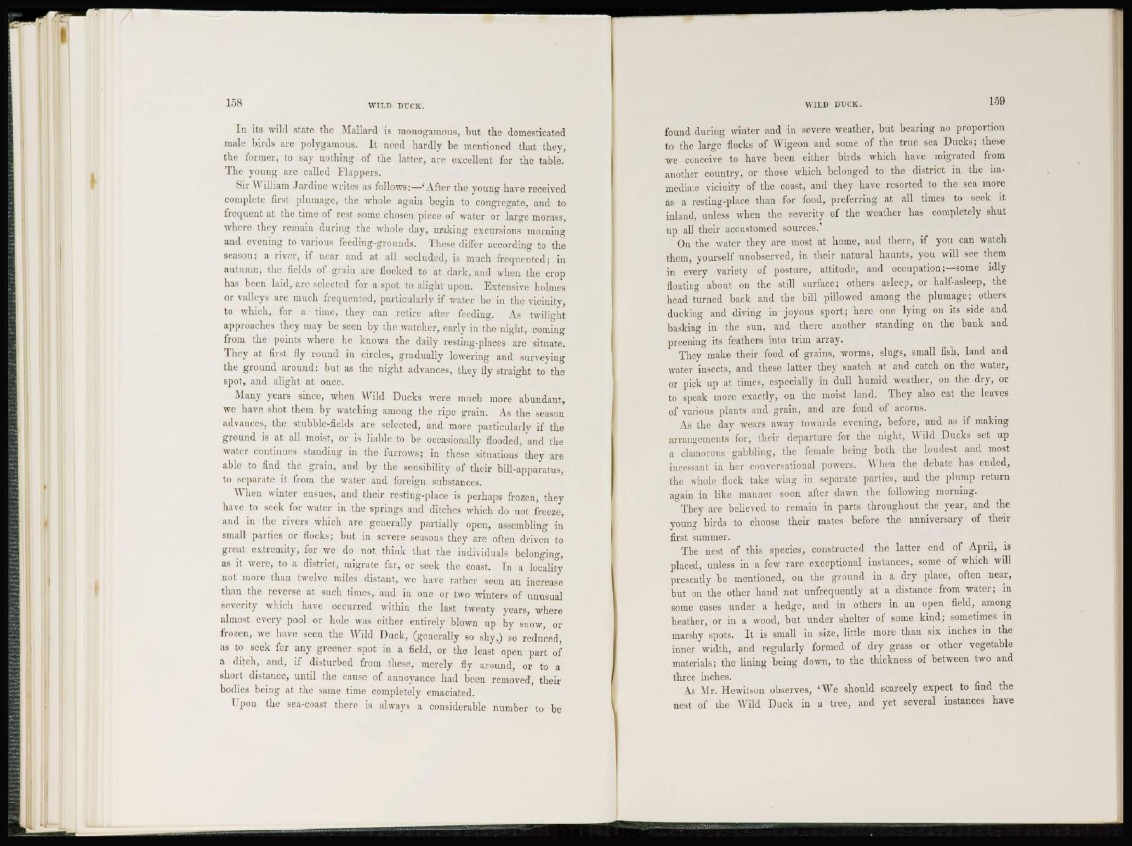
In its wild state the Mallard is monogamous, hut the domesticated
male birds are polygamous. It need hardly be mentioned that they,
the former, to say nothing of the latter, are excellent for the table.
The young are called Flappers.
Sir William Jardine writes as follows:—'After the young have received
complete first plumage, the whole again begin to congregate, and to
frequent at the time of rest some chosen piece of water or large morass,
where they remain during the whole day, making excursions morning
and evening to various feeding-grounds. These differ according to the
season; a river, if near and at all secluded, is much frequented; in
autumn, the fields of grain are Hocked to at dark, and when the crop
has been laid, are selected for a spot to alight upon. Extensive holmes
or valleys are much frequented, particularly if water he in the vicinity,
to which, for a time, they can retire after feeding. As twilight,
approaches they may be seen by the watcher, early in the night, coming
from the points where he knows the daily resting-places are situate.
They at first fly round in circles, gradually lowering and surveying
the ground around: but as the night advances, they fly straight to the
spot, and alight at once.
Many years since, when Wild Ducks were much more abundant,
we have shot them by watching among the ripe grain. As the season
advances, the stubble-fields are selected, and more particularly if the
ground is at all moist, or is liable to be occasionally flooded, and the
water continues standing in the furrows; in these situations they are
able to find the grain, and by the sensibility of their bill-apparatus,
to separate it from the water and foreign substances.
When winter ensues, and their resting-place is perhaps frozen, they
have to seek for water in the springs and ditches which do not freeze,
and in the rivers which are generally partially open, assembling in
small parties or flocks; but in severe seasons they are often driven to
great extremity, for we do not think that the individuals belonging,
as it were, to a district, migrate far, or seek the coast. In a locality
not more than twelve miles distant, we have rather seen an increase
than the reverse at such times, and in one or two winters of unusual
severity which have occurred within the last twenty years, where
almost every pool or hole was either entirely blown up by snow, or
fro/en. we have seen the Wild Duck, (generally so shy,) so reduced,
as to seek for any greener spot in a field, or the least open part of
a ditch, and, if disturbed from these, merely fly around, or to a
short distance, until the cause of annoyance had been removed, their
bodies being at the same time completely emaciated.
Upon the sea-coast there is always a considerable number to be
found during winter and in severe weather, but bearing no proportion
to the large flocks of Wigeon and some of the true sea Ducks; these
we conceive to have been either birds which have migrated from
another country, or those which belonged to the district in the immediate
vicinity of the coast, and they have resorted to the sea more
as a resting-place than for food, preferring at all times to seek it
inland, unless when the severity of the weather has completely shut
up all their accustomed sources.'
On the water they are most at home, and there, if you can watch
them, yourself unobserved, in their natural haunts, you will see them
in every variety of posture, attitude, and occupation;—some idly
floating about on the still surface; others asleep, or half-asleep, the
head turned back and the bill pillowed among the plumage; others
ducking and diving in joyous sport; here one lying on its side and
basking in the sun, and there another standing on the bank and
preening its feathers into trim array.
They make their food of grains, worms, slugs, small fish, land and
water insects, and these latter they snatch at and catch on the water,
or pick up at times, especially in dull humid weather, on the dry, or
to speak more exactly, on the moist land. They also eat the leaves
of various plants and grain, and are fond of acorns.
As the day wears away towards evening, before, and as if making
arrangements for, their departure for the night, Wild Ducks set up
a clamorous gabbling, the female being both the loudest and most
incessant in her conversational powers. When the debate has ended,
the whole flock take wing in separate parties, and the plump return
again in like manner soon after dawn the following morning.
They are believed to remain in parts throughout the year, and the
young birds to choose their mates before the anniversary of their
first summer.
The nest of this species, constructed the latter end of April, is
placed, unless in a few rare exceptional instances, some of which will
presently be mentioned, on the ground in a dry place, often near,
but on the other hand not unfrequently at a distance from water; in
some cases under a hedge, and in others in an open field, among
heather, or in a wood, but under shelter of some kind; sometimes in
marshy spots. It is small in size, little more than six inches in the
inner width, and regularly formed of dry grass or other vegetable
materials; the lining being down, to the thickness of between two and
three inches.
As Mr, Hewitson observes, ' W e should scarcely expect to find the
nest of die Wild Duck in a tree, and yet several instances have